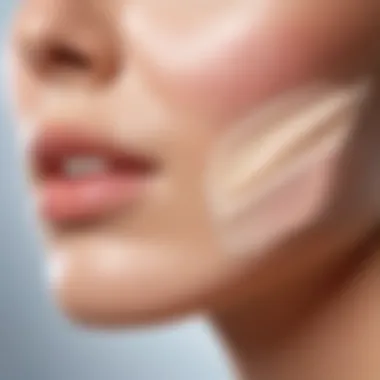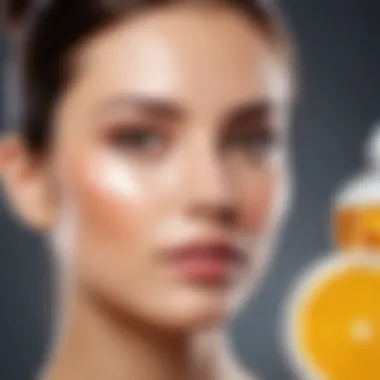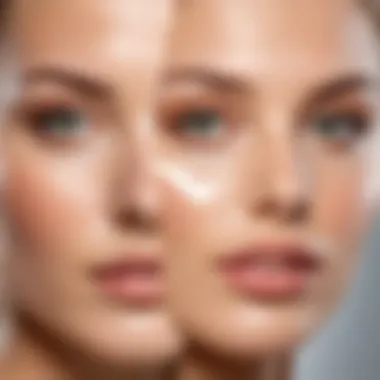Understanding Skin Protection Products: Components & Classifications


Intro
In the realm of skincare, understanding skin protection products is essential. These products play a crucial role in maintaining skin health. With an abundance of options available, consumers often find it challenging to navigate through the various ingredients and classifications.
This article aims to simplify that journey. By dissecting the components of skin protection products, it will help individuals make informed choices based on their specific needs and skin types.
Popular Deals and Offers
Overview of Current Discounts on Cosmetics Brands
Many well-known cosmetic brands offer promotions periodically. These discounts can significantly reduce the cost of high-quality skin protection products.
For instance, brands like Neutrogena, La Roche-Posay, and CeraVe often provide seasonal sales. Keeping an eye on their official websites and social media can lead to opportunities for savings.
Seasonal Sales and Special Offers
Sales are particularly prevalent during holidays or the change of seasons. Events like Black Friday or summer sales often feature deep discounts on skincare items. Subscribing to newsletters is a wise strategy to stay updated on these limited-time offers.
Choosing the Right Skincare Products
How to Select Cosmetic Products by Skin Type
Identifying your skin type is the first step. Skin types can generally be classified as dry, oily, combination, or sensitive. Different products cater to these specific needs. For example, a person with dry skin should look for moisturizing creams, while oily skin may benefit from lightweight gels.
Tips for Choosing Products for Different Age Groups
Age can also influence skin care needs. For young adults, products focusing on prevention and hydration might be key. As people age, they may seek products that address concerns like fine lines or age spots.
Understanding the subtle differences in skin needs across age groups is crucial for effective skincare.
"Choosing the right skin protection product can greatly enhance the health and appearance of your skin, making it essential to understand the components involved."
Prologue to Skin Protection
Skin protection is a crucial aspect of maintaining overall health. The skin is our body's first line of defense against environmental factors such as harmful UV rays, pollution, and pathogens. Understanding skin protection products can empower individuals to make informed choices about their skincare routines. This article aims to explore various skin protection products, their components, classifications, and their significance in our daily lives.
The primary benefits of skin protection include prevention against skin damage, promoting hydration, and aiding in the maintenance of skin health. Factors like age, skin type, and environmental exposure can dictate how a person should approach skin protection. Thus, it becomes vital to seek products tailored to individual needs.
By understanding the various types of skin protection products available, people can select formulations that not only protect but also nourish their skin. Consumers often face confusion due to the vast selection on the market, leading to suboptimal choices. This article will clarify these categories and their unique characteristics to enhance your understanding of skin care.
Importance of Skin Protection
Skin health is often overlooked. Many do not realize how essential it is to shield this organ from external threats. Skin protection products can prevent various skin conditions, ranging from dryness to serious ailments such as skin cancer. Regular use of the right products can dramatically improve skin appearance and longevity.
Moreover, many skin protection formulations include beneficial ingredients that nourish skin, making it look youthful and vibrant. This becomes particularly important as individuals age, as the skin's natural ability to retain moisture declines. A proactive approach in skincare, especially with reputable products, is both an investment and a necessity.
Types of Skin Protection Products
There are several types of skin protection products, each designed to address specific needs. Understanding these categories can help consumers choose wisely. Some of the most common types include:
- Moisturizers: These products are critical in maintaining skin hydration. They often contain ingredients that help retain moisture.
- Sunscreens: Protect against UV damage. They come in various formulations, including chemical and physical filters.
- Barrier Creams: Create a protective layer on the skin, guarding against pollutants and irritants.
- Anti-Aging Products: Target signs of aging through various mechanisms, such as improving skin texture and elasticity.
Understanding what product to use when and why is essential for developing a successful skincare routine that promotes healthy skin.
Classification of Skin Protection Products


The classification of skin protection products is crucial for understanding the diverse ways in which these items can benefit the skin. Each type of product serves specific functions, targeting various skin concerns and conditions. Recognizing these classifications helps individuals make informed decisions tailored to their unique needs. This understanding can enhance the effectiveness of a skincare regimen and promote healthier skin overall.
Moisturizers
Moisturizers play a foundational role in any skin care routine. They function primarily to hydrate the skin and create a protective barrier that minimizes water loss. There are different formulations available, each catering to specific skin types. For instance, gel-based moisturizers may be suitable for oily skin, as they hydrate without adding excess oil. On the other hand, cream-based products are often richer and provide deeper hydration for dry or combination skin.
Key Benefits of Moisturizers:
- They combat dryness and flakiness.
- They improve skin texture and elasticity.
- They enhance the skin’s ability to retain moisture.
Considerations When Choosing a Moisturizer:
- Look for ingredients like glycerin and hyaluronic acid, known for their hydrating properties.
- Consider the formulation type based on your skin type for optimal results.
Sunscreens
Sunscreens are essential in protecting the skin from harmful UV radiation. They help prevent sunburn, premature aging, and skin cancers. There are two main categories of sunscreen: chemical filters and physical filters. Chemical filters absorb UV rays and convert them into heat, while physical filters, which typically contain zinc oxide or titanium dioxide, reflect the rays away from the skin.
Using a broad-spectrum sunscreen is advisable, as it protects against both UVA and UVB rays. Daily application, even on cloudy days, is a critical practice for maintaining skin health.
Key Functions of Sunscreens:
- They protect against UV damage.
- They reduce the risk of skin cancer.
- They help prevent premature aging signs such as wrinkles and age spots.
Barriers Creams
Barrier creams provide an additional layer of protection by preventing irritants and allergens from coming into contact with the skin. They are particularly beneficial for individuals working in environments with harsh conditions or those prone to skin irritations. These creams create a barrier that locks in moisture and shields the skin from external elements.
Key Benefits of Barrier Creams:
- They help maintain skin hydration.
- They protect against environmental stressors such as wind and pollution.
- They can soothe existing irritations or redness.
When selecting a barrier cream, ingredients like dimethicone and glycerin are commonly effective in enhancing protection and hydration.
Anti-Aging Products
Anti-aging products encompass a wide range of formulations designed to combat signs of aging such as fine lines, wrinkles, and loss of firmness. Ingredients like retinoids, peptides, and antioxidants are often found in these products for their reparative properties.
Using these products consistently can yield significant improvements in skin texture and appearance.
Key Considerations for Anti-Aging Products:
- Look for products containing retinol for encouraging cellular turnover.
- Antioxidants like vitamin C can help mitigate free radical damage.
- Be mindful of formulations designed for your specific skin type to ensure effectiveness without irritation.
"A suitable product for your skin type paired with a proper application routine can greatly enhance your skin’s health and appearance."
Choosing the right skin protection product begins with understanding these classifications. With careful consideration, individuals can create an effective skincare routine that supports their skin's health across various conditions and environments.
Key Components of Skin Protection Products
Understanding the key components of skin protection products is essential for making informed choices regarding skincare. These elements contribute not only to the effectiveness of the products but also to their overall impact on skin health. The main components of skin protection products include humectants, emollients, occlusives, and active ingredients. Each of these components plays a distinct role and offers unique benefits to the skin.
Humectants
Humectants are substances that attract moisture from the environment into the skin. Their primary function is to enhance the skin's hydration levels by drawing water molecules. Common humectants include glycerin, hyaluronic acid, and urea. The usage of humectants is often associated with improved skin texture and elasticity. One key aspect to keep in mind when choosing a product with humectants is the climate. In very dry conditions, a humectant may not be as effective without the support of occlusives, which help to lock in moisture.


Emollients
Emollients are compounds that help soften and smooth the skin by filling in gaps between skin cells. They work to create a barrier that helps retain moisture, making them particularly beneficial for those with dry or rough skin. Some examples include shea butter, cocoa butter, and various oils such as jojoba or almond oil. The key characteristic of emollients is their ability to provide a silky and smooth feel to the skin. They can be especially valuable in formulations aimed at improving the appearance of dry, flaky patches.
Occlusives
Occlusives create a physical barrier on the skin's surface, preventing moisture loss. They are essential for maintaining hydration, especially in harsh environmental conditions. Common occlusives include petroleum jelly, lanolin, and beeswax. These ingredients are often found in thick creams and ointments. The unique feature of occlusives is their longevity; they can provide extended protection against moisture loss. However, some individuals may find occlusives too heavy or greasy for daily use.
Active Ingredients
Active ingredients in skin protection products serve specific purposes, often targeting various skin concerns. They can include several subcategories such as SPF agents, antioxidants, and peptides.
SPF Agents
SPF agents are crucial in providing protection against ultraviolet (UV) radiation, which is a significant contributor to skin damage and aging. The key characteristic of SPF agents is their ability to absorb, reflect, or scatter UV rays. This feature makes them a popular choice for daily skincare, as they help protect the skin from sun-induced harm. The use of SPF products can significantly reduce the risk of sunburn, skin cancer, and premature aging. One consideration is that SPF protection must be reapplied every few hours, especially during prolonged sun exposure.
Antioxidants
Antioxidants are powerful agents that help protect the skin from oxidative stress caused by free radicals. Common antioxidants include vitamin C, vitamin E, and green tea extract. The unique feature of antioxidants is their ability to neutralize free radicals, which can lead to cellular damage. Their incorporation in skincare products is beneficial for promoting a youthful appearance and enhancing skin radiance. While they are largely beneficial, it's important to note that not all antioxidants are stable in all formulations, which may affect their efficacy.
Peptides
Peptides are short chains of amino acids that play a critical role in various skin functions, including collagen production. The primary characteristic of peptides is their ability to signal skin cells to encourage regeneration and repair. As a result, they are often included in anti-aging products. Peptides can be beneficial for enhancing skin firmness and reducing the appearance of fine lines. However, the efficacy of peptides can vary depending on the formulation and concentration used, requiring careful assessment when choosing products that contain them.
Sunscreen Ingredients and Their Functions
Sunscreen is integral to skin protection, shielding the skin from harmful ultraviolet rays. The ingredients within sunscreens are categorized primarily into chemical and physical filters. Each group operates differently, providing unique benefits. Understanding these components is crucial for making informed choices about skin care products. By knowing the distinctions, users can find the most effective formulations for their needs.
Chemical Filters
Chemical filters are organic compounds that absorb UV radiation. When applied to the skin, they undergo a chemical reaction that transforms UV rays into heat, which is then released from the skin. Some common chemical filters include avobenzone, oxybenzone, octisalate, and octocrylene. These filters offer several advantages:
- Broad Spectrum Protection: Many chemical filters provide broad-spectrum protection against both UVA and UVB rays.
- Cosmetic Appeal: They tend to have a lighter feel on the skin, making them preferable for daily use under make-up.
- Variety of Formulations: Chemical sunscreens can be found in various forms, including lotions, sprays, and gels.
However, certain considerations should be noted. Some individuals may experience allergic reactions to specific chemical UV filters. Choosing products labeled as hypoallergenic can mitigate this risk.
Physical Filters
Physical filters, also known as mineral sunscreens, contain active mineral ingredients like zinc oxide and titanium dioxide. These compounds sit on top of the skin and act as a barrier to reflect and scatter UV radiation. The advantages of using physical filters include:
- Immediate Protection: Physical sunscreens provide protection immediately upon application, unlike some chemical filters that need time to absorb.
- Less Irritation: They are less likely to cause skin irritation, making them suitable for sensitive skin types.
- Stable Formulas: Physical filters generally remain stable in sunlight, ensuring longer-lasting protection.
Nonetheless, physical sunscreens may leave a white cast on the skin, a common concern for many users. New formulations are emerging that minimize this effect, enhancing cosmetic appeal.
Important Note: Both chemical and physical filters must be reapplied regularly, especially after swimming or sweating, to maintain effective protection.
Understanding these two categories of sunscreen ingredients helps consumers integrate effective sun protection into their skincare routine. Selecting a product based on individual skin type and sensitivity is vital for achieving optimal results.
Choosing the Right Skin Protection Product
Choosing the right skin protection product is crucial for effective skincare. Each product serves specific purposes, tailored to different skin types and environmental concerns. Selecting the appropriate product can enhance protection against damaging elements such as UV rays, pollution, and harsh weather conditions. Moreover, it can support overall skin health and appearance. A product that does not match individual skin needs may result in adverse reactions or ineffectiveness.
Deciding on the right skin protection requires being informed about one’s skin type. Different skin types react distinctively to various ingredients found in these products. Furthermore, understanding the ingredients listed on product labels is vital. They can guide consumers towards safe choices whilst avoiding potential irritants. This section delves into the specific skin types and how they influence product selection.
Understanding Skin Types


Oily Skin
Individuals with oily skin produce excess sebum, leading to a shiny appearance. This characteristic can contribute to acne and enlarged pores. Despite this, oily skin is also a favorable type for some skin protection products. Products that are gel-based or oil-free tend to work well. They provide hydration without adding extra oil to the skin.
A unique feature of oily skin is its ability to resist signs of aging, such as wrinkles. This is because the natural oils keep the skin moisturized for longer. However, excessive oiliness can lead to clogged pores, necessitating careful selection of skin protection products that contain non-comedogenic ingredients, which do not block pores.
Dry Skin
Dry skin lacks sufficient moisture and often feels tight or rough. It can be sensitive and prone to irritation. For individuals with dry skin, products that are rich in emollients and humectants are beneficial. These ingredients help to restore hydration and create a barrier against environmental stressors.
A key characteristic of dry skin is its tendency to flake and appear dull. Using products that contain shea butter or glycerin can alleviate these issues, providing significant relief. However, it is important to note that some products can be too heavy, leading to breakouts. Therefore, selecting a lightweight moisturizer is essential for maintaining balance.
Combination Skin
Combination skin presents a unique challenge, as it includes areas that are both oily and dry. Commonly, the T-zone (forehead, nose, and chin) may be oily while the cheeks remain dry. Recognizing this dual characteristic is crucial for selecting the right skin protection product.
Lightweight lotions or products formulated specifically for combination skin are ideal. They hydrate dry areas without overwhelming the oilier zones. The adaptability required by combination skin makes it a popular focus for many products that aim to target multiple issues simultaneously. However, it is necessary to avoid overly drying ingredients that could disrupt balance between the two skin types.
Reading Labels and Ingredients
Reading labels is essential when choosing skin protection products. Ingredients should be scrutinized carefully to ensure they match skin needs and do not cause harm. Key elements to look for include active ingredients like SPF agents for sun protection and antioxidants that can help combat environmental damage. Additionally, it is important to be aware of potentially harmful additives, which may irritate the skin.
Ingredients are often listed in order of concentration. Therefore, it’s wise to choose products where effective ingredients are prominent on the list. Understanding labels can empower individuals to make informed decisions about their skincare, aligning products closely with their skin condition and ongoing concerns.
"Know your skin type and read labels carefully. This knowledge is your first line of defense in maintaining healthy skin, tailored to your specific needs."
Safety and Effectiveness of Skin Protection Products
The topic of safety and effectiveness in skin protection products is paramount. It highlights the need for informed choices when selecting formulations that will be applied directly to the skin. This section examines essential elements regarding both safety and effectiveness of these products, with regard to their ingredients, compliance with regulations, and potential adverse effects.
Regulatory Standards
Regulatory standards govern the production and distribution of skin protection products. Various organizations set out these regulations to protect consumers from harmful substances. In the United States, the Food and Drug Administration (FDA) plays a crucial role in this realm. It oversees the approval and safety evaluation of sunscreens and other skin protection products, ensuring they meet established safety criteria before reaching the market.
In the European Union, regulations differ, but similar principles apply. The Cosmetics Regulation (EC) No 1223/2009 ensures that cosmetics, including skin protection products, are safe for human health. This legal framework holds manufacturers responsible for ensuring product safety.
Furthermore, products often undergo rigorous testing for efficacy before they can claim specific benefits. Many have to provide evidence of their claims via clinical studies, adding another layer of consumer protection. Awareness regarding these standards empowers consumers to choose products backed by scientific validation.
Allergies and Reactions
The potential for allergies and adverse reactions to skin protection products is significant. Ingredients in these formulations can cause skin irritations or allergic responses in some individuals. Common allergens include fragrances, preservatives, and certain alcohols. Recognizing one's sensitivities is crucial for minimizing the risk of adverse skin reactions.
It is advisable to conduct a patch test before fully applying a new product, especially for those with sensitive skin. This involves applying a small amount of the product on a discreet area to check for any reactions over 24 to 48 hours.
"Understanding the ingredients and conducting patch tests plays a vital role in ensuring safety and comfort when using skin protection products."
Moreover, some users may experience conditions like contact dermatitis, which can stem from prolonged usage of particular ingredients. If irritation occurs, it is essential to discontinue the product immediately and consult a dermatologist for proper assessment and alternatives.
In summary, safety and effectiveness are crucial aspects when choosing skin protection products. Awareness of regulatory standards and potential allergens fosters informed decisions and contributes to the overall health and wellness of one’s skin.
Finale
In concluding this discourse on skin protection products, it is paramount to underscore the significance of understanding these products in the context of skincare. As the skin acts as the body’s first line of defence against environmental aggressors, utilizing the right protection products can greatly enhance skin health and appearance. Given the multitude of options available, consumers must be well-informed to make appropriate choices.
Future Trends in Skin Protection
The landscape of skin protection is evolving rapidly. Recent advancements in formulation science are leading to more effective and tailored solutions. Here are some foreseeable trends that will likely shape the future of skin protection products:
- Personalization: As skincare becomes increasingly individualized, products tailored to specific skin types and conditions will continue to gain popularity. Brands are exploring the use of technology to customize formulations based on genetic insights and personal lifestyle data.
- Sustainability: Environmental concerns are driving a significant shift toward eco-friendly packaging and sustainably sourced ingredients. Brands are under pressure to reduce their carbon footprint and embrace practices that do not harm the environment.
- Technological Integration: The incorporation of technology in skincare routines is on the rise. From apps that analyze skin texture to augmented reality for simulating products, technology will play a pivotal role in bridging gaps in consumer knowledge and product efficacy.
- Multifunctional Products: There is a growing demand for products that offer multiple benefits, like combining moisturizers with SPF and anti-aging ingredients. Consumers prefer options that streamline their skincare routine without compromising results.
"Understanding your skin and choosing the right protection product can lead to improved skin health and a dynamic skincare routine."
The exploration of these trends indicates a dynamic future where skin health products are not only more accessible but also more sophisticated. In summary, being aware of these trends encourages consumers to engage with the market thoughtfully, ensuring that they invest in products that truly meet their skin's needs.















